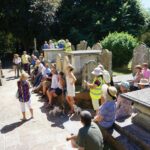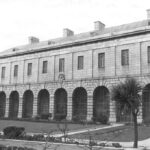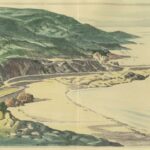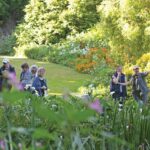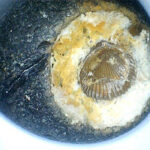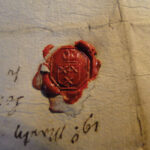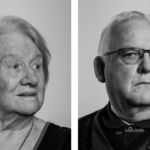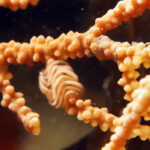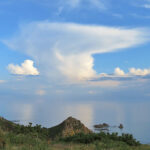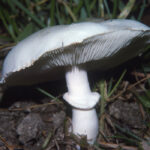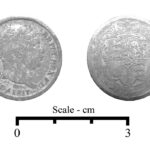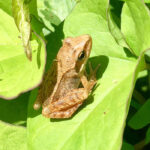God is a pure no-thing, concealed in now and here;
the less you reach for him, the more he will appear.
Angelus Silesius
One of the largest and most significant collections ever acquired by the photographic archive of the Société Jersiaise is that of Arthur Ernest Mourant (1904–1994), a scientist whose work fundamentally transformed biological anthropology, particularly in the study of blood groups. Mourant’s early academic career spanned chemistry, geology, and medicine, with studies at Oxford and St Bartholomew’s Medical College. Although he initially pursued geology, the economic downturn of the 1930s led him to shift his focus to medical research. He eventually became the founder and first director of the Blood Group Reference Laboratory in London, where he led pioneering research on the global distribution of blood groups. His landmark publication, The Distribution of the Human Blood Groups (1954), and its expanded second edition in 1976, became foundational texts in anthropology, offering insights into human evolution and migration.
While studying his life and cataloguing a section of the collection he donated to the Société Jersiaise—which includes several monochrome photographic prints, maps, and a few cyanotypes—I began to understand the profound significance that geology held for him. At first, his photographs appeared to be merely focused on precise documentation, often disregarding any aesthetic considerations. However, some of his work reveals a sporadic yet acute sensitivity—perhaps a sense of wonder that compelled him, through his camera, to acknowledge the beauty both in and beyond the subjects he initially approached from an objective perspective. For anyone studying his collection, this dynamic suggests an inherent sense of movement: Mourant is always wandering, exploring, gathering data, and measuring. Among the hundreds of photographs where the camera is directed at stones, minerals, dolmens, and rock formations—whether on the ground or in obscure caves—he occasionally lifts his gaze to look beyond his immediate objects of study. In these moments, he quietly, yet unmistakably, exposes something of himself. This essay, therefore, seeks to explore Mourant’s early geological pursuits while also examining the aesthetic sensitivity that transcends his scientific endeavours.

Arthur Mourant was born in Jersey on April 11, 1904, on a farm, just two hundred yards from the ancient megalithic tomb of La Hougue Bie. This farm had been home to the Mourant family since at least 1818. Nearly all of Mourant’s ancestors were farmers, including his grandfather, Charles Mourant, a leading breeder of the now world-famous Jersey cattle. The household was influenced by a strong religious faith, which, alongside the family’s farming tradition, shaped the early life and values of young Arthur Mourant. However, his path would eventually diverge in a radical way. From a young age, he displayed signs of a scientific curiosity, an eagerness to understand the origins of things. In his autobiography Blood and Stones (1995), he recounts a childhood memory that hints at this early interest. During a chapel outing in horse-drawn vans, possibly for a choir picnic on Whit Monday, he and his family visited the Wolf Caves. Mourant, only five years old at the time, was not allowed to descend the steep path and was left behind in a tearoom with his mother. Despite this, he was captivated by the majestic natural formation nestled at the bottom of a towering cliff. Recognising that Arthur had missed out on the excursion, his father sought to make amends by taking him to Plemont and Grève au Lançon that same day. There, Mourant had his first opportunity to explore intricate rock formations. The cave’s mouth, opening wide towards the sea, allowed sunlight to dance on its rugged surfaces, partially veiled by mist. The vision of these caves made a lasting impression on him. On the journey home, he could not stop wondering who had crafted such structures. When he asked his mother who made the Wolf Caves, she replied that God had made them. He then asked his father who made the Plemont Caves, and he answered, the sea.
Unintentionally, Mourant’s parents were echoing the gradual shift from biblical to scientific interpretations of Earth’s geology that began in the late 18th century, largely influenced by naturalist James Hutton who, coincidentally, was also a farmer. During this period, the dominant belief among natural philosophers was that Earth had been created by God around 6,000 years ago, initially as the Garden of Eden—a primeval, perfect, divine realm that had since fallen into its current, corrupted state due to the first sin. Hutton, however, spent many years of his life—remaining unmarried and conducting fieldwork primarily in Scotland—collecting rocks and formulating theories that sought to explain the incessant transformation of the planet. His work played a pivotal role in challenging and eventually dismantling entrenched religious doctrines by grounding his arguments in scientific evidence. Hutton’s theories enriched the ongoing debates of the time that continued into the 19th century. Especially important were the debates between Catastrophists and Uniformitarians, as well as Neptunists and Plutonists, which were central to the development of modern geological thought.

In retrospect, it could be said that Mourant’s mother aligned with the Catastrophist theories, which postulated that Earth’s geological features were the result of sudden, cataclysmic events, often attributed to divine intervention, such as the biblical flood. In contrast, his father, by ascribing the creation of the caves to the sea, unwittingly embraced a Neptunist perspective—a geological theory named after Neptune, the ancient Roman god of the sea, which attributes the formation of rocks and landscapes primarily to the action of water. Despite the fact that Mourant questioned his parents about the origin of the caves long after Hutton had challenged religious interpretations of Earth’s history, he spent much of his childhood and adolescence grappling with the tension between evangelical teachings and scientific inquiry. His family life was deeply rooted in Methodist religious beliefs, characterised by strict Sabbatarianism and a stringent moral code that condemned activities like dancing or attending the theatre as sinful. Consequently, his upbringing was marked by the rigorous demands of farm work and regular attendance at the Wesleyan Methodist Church. The household was steeped in devoutness, where hymns were often sung, and Biblical stories were read aloud, reinforcing the strong spiritual convictions that shaped his worldview. Apparently, Sunday School left a lasting impact on him, particularly due to the foreboding doctrines often preached, such as the General Resurrection of the Dead and the Day of Judgement.
However, it was the concept of the End of the World that affected him most profoundly, causing him to frequently awaken in the middle of the night, terrorised by apocalyptic nightmares. His father, however, seemed inclined to nurture his emerging enthusiasm for science. When Mourant was 11 years old, he not only gave him a Kodak Brownie camera but also sent him to Albert Smith’s studio, where he received lessons in developing and printing, which served as an introduction to chemistry. It was perhaps at Victoria College that Mourant first began to think more freely for himself. He read Unto This Last (1860), an essay by John Ruskin which critiques the economic theories of the 18th and 19th centuries, predominantly those promoting industrialism and laissez-faire economics. Mourant later credited this book with inspiring his lifelong commitment to socialism. College also allowed him to explore his interest in geology more deeply, mainly when his French teacher, Edmund Toulmin Nicolle, suggested he join the Société Jersiaise. Nevertheless, according to his own account, he was most indebted to his science teacher, A. J. Robinson, who taught him that ‘the truly scientific approach is not to believe anything.’

The statement must have had a profound influence on him. Later in life, while studying psychoanalysis, he admitted that, during his adolescence, he had felt a strong aversion to the idea of dedicating his heart to Christ. In fact, at 17 years old, grappling with profound existential inquiries, he started doubting the very nature of reality: ‘What can I believe? There must be my conscious self, aware of sensations, whether real or illusory, but there must also be something external to my consciousness causing these sensations or illusions—this must be God. Yet—and here I hardly dare confess the blasphemous thought—could I be God, who has put Himself to sleep and is now dreaming the very experiences I am having?’. The reflection appears to suggest a syncretism between Descartes’ Discourse on Method (1637) and certain mystical or metaphysical traditions, particularly within Advaita Vedanta and the idea of Māyā in Hindu philosophy, which considers the world an illusion (Māyā) or a projection of Brahman, the ultimate reality, meaning that reality is merely a dream or an illusion created by this divine consciousness. Nevertheless, questioning whether what our senses present to us is a mirage might nowadays sound like a philosophical trope—one that literature and cinema have so extensively relied upon that its impact has diminished. Yet, despite its overuse in culture, this question remains a crucial starting point for understanding the fundamentals of reality. It introduces us to the inquisitive spirit of science precisely because it forces us to confront the unsettling fact that our senses are far from reliable. What we see, hear, touch, and feel are not always accurate representations of the world as it truly is. This realisation can be both disorienting and liberating, as it pushes us to question the very foundations of our understanding. Moreover, when considering the rigorous religious tradition of the Mourant family, it becomes clear that for an adolescent to pose such a question required not just intellectual curiosity, but also a significant dose of courage and rebellion. This is not merely a child doubting the existence of a deity that has been the cornerstone of his family’s beliefs; it is a young mind daring to explore the possibility of a reality where he, himself, might possess a divine role—one where the very fabric of reality is subjective and treacherous, shaped by his perceptions and interpretations. Mourant’s contemplation of being a God—perplexed and entangled in the illusions created by his senses—reflects a profound inquiry into the nature of existence itself. This emerging philosophical analysis aligns closely with geology, a discipline that similarly challenges surface-level perceptions to uncover deeper truths. What appears stable and permanent on the surface is, in fact, part of a continuous process of transformation, the metamorphic essence of everything. And that was precisely what captivated Mourant the most.
In 1922, after leaving school and securing a scholarship to Oxford, Mourant spent much of the summer engaged in geological explorations and mapping projects alongside A. J. Robinson and his wife. This experience showcased his early talent for meticulous observation and attention to detail—skills that would later become hallmarks of his career. This period was not just formative; it highlighted Mourant’s preference for hands-on, empirical research over abstract academic pursuits, which he found less engaging. Interestingly, at Oxford, Mourant chose to focus his studies on chemistry. However, an introductory lecture on the principles of symmetry in crystals by T. V. Barker soon captivated him, marking the most exciting intellectual experience of his undergraduate years. The concept of symmetry unveiled what he considered to be an underlying order in what might otherwise appear chaotic, not only defining the visual beauty of crystals but also determining their physical and chemical properties. Perhaps this interest in the perpetual relationship between chaos and order led him to a deeper exploration of geological formations, such as those that exhibit this duality in their very structure. Upon completing his studies at Oxford with distinction, Mourant was awarded the King Charles I Scholarship, which allowed him the freedom to pursue his research interests, and he returned to his native Jersey, choosing to study the Precambrian volcanic rocks that had long intrigued him. This decision was influenced not only by his roots but also by the complex geological history of the Channel Islands, where ancient volcanic activity had left behind a rich tapestry of formations.

Over the next two years, he dedicated himself to mapping the geological landscape of Jersey and its surrounding regions, including parts of France such as Normandy and Brittany, where he took more than a thousand photographs. Most of the sedimentary rocks he studied, affected by igneous intrusions, provided records of a dynamic natural history and the processes that had moulded them. His fieldwork allowed him to piece together the violent history and transformative events that crafted these structures. During this time, Mourant also delved into the study of seismic activity in the Channel Islands, prompted by a series of earthquakes that began in 1925. This period in Jersey marked a significant turning point in his career, with one notable discovery occurring at the Gigoulande granite quarry. There, he encountered a small, loose fragment of pegmatite exhibiting black streaks on its surface. Mourant suspected these streaks might be indicative of radioactive material, possibly uranium oxide, and placed the specimen on a photographic plate for several days, confirming his initial hypothesis—the black streaks were indeed strongly radioactive. Intrigued by this finding, Mourant sought further expertise, sending the specimen to Professor W. I. Gordon of King’s College, London, who corroborated Mourant’s observations and suggested the mineral might be euxenite, a columbate-tantalate containing rare earth elements and uranium. Although Mourant temporarily misplaced the specimen, he rediscovered it approximately two decades later and forwarded it to Dr. Clive Bishop, then the keeper of minerals at the Natural History Museum. Bishop’s analysis reaffirmed the specimen’s radioactive nature. The specimen was the only known occurrence of its kind in the British Isles, suggesting an improbable geological event had led to its formation at Gigoulande. It was not until half a century after Mourant’s initial discovery that the mineral was finally identified as uranopyrochlore.
In 1928, upon returning to England, things did not go well for him. After completing his thesis, he earned a Doctor of Philosophy degree (at that time, studies in science and other disciplines were still classified as ‘philosophy’ due to the Renaissance belief that true knowledge could be derived from empirical observation) and was offered a position with the Geological Survey, where he was assigned to map the coalfield area around Chorley, the administrative centre of the wider Borough of Chorley in Lancashire. However, he soon regretted accepting the offer. Not only was he ill-suited for the Civil Service, but he also struggled to get along with his colleagues, with whom he was living in a rural pub, venturing out solely to explore the glacial boulder clay. Before long, his work was deemed unsatisfactory, and the director suggested he submit his resignation. Unemployed and disoriented amidst a global economic recession, he attempted to apply for a Commonwealth Fellowship to study continental drift—a theory that was still controversial at the time—but he was unable to secure a position and was forced to return once again to his parents’ house without money or a clear sense of his professional future. Some relief came when he was offered a temporary job at his old school, Victoria College, which provided him with enough time to continue his geological work and to study a new field of interest: polarised light, the phenomenon in which light waves vibrate in only one direction or angle, as opposed to regular light waves, such as those in sunlight, which vibrate in multiple directions—vertically, horizontally, or at any angle in between.

Feeling he had failed and was unable to make a living with his degree, this period marked the end of his career in geology. Despite his qualifications, he was perceived as overqualified for teaching positions and was unable to secure a role in his field. Mourant later described this time as ‘the most difficult’ of his career. However, throughout this problematic period, he never stopped taking photographs. His later focus on polarised light and its general phenomena resulted in remarkable photos that transcended the subject itself, perhaps inadvertently reflecting his own struggles and emotional state. One of the most eloquent captures a living room at twilight, with a beam of light piercing through the window, illuminating both the curtains—blown by a gentle breeze—and the room with a golden glow. The light cuts through the shadows, creating a stark contrast between the illuminated and darkened areas. Dust particles dance in the beam, shimmering in a serene, familiar atmosphere. The room, otherwise mundane, is transformed by this profound play of light and shadow, evoking a sense of calm and wonder. The scene captures a fleeting moment of beauty where the ordinary becomes extraordinary through the lens of light. Many other photographs provoke the observer in different ways: ominous thunderbolts fracturing the night sky, dark forests or castles subtly emerging in the background; fireworks captured at the moment they explode, leaving fiery, phantasmagorical shapes over a darkened city; powerful beams of light cutting through empty windows like flames in a derelict building; multiple silhouettes from above casting shadows on a public plaza; a lone, uncanny figure on a rugged rock formation, outlined against dawn or dusk; and the façade of a café where two men drink wine in front of a demijohn, likely taken during geological explorations in Brittany and Normandy. These photographs, unrelated to his academic studies, are not accidents but the work of a man who simultaneously dissects the world and recognises its poetic manifestations.
At some point Mourant decided to experiment with cyanotypes. He used negatives and applied Herschel’s formula to develop them on small, square pieces of faint-ruled paper torn from a notebook. The limited number of photographs suggests he was merely testing the process. Cyanotype development involves mixing two main chemicals—potassium ferricyanide and ferric ammonium citrate—which are applied to paper or fabric. Once dried, this surface is exposed to ultraviolet light, creating an image by turning exposed areas blue through a chemical reaction that produces Prussian blue pigment (the term cyanotype derives from the Greek κυάνεος, kyáneos, meaning ‘dark blue’). The image is then developed by washing the surface with water. Mourant left behind 26 cyanotypes, some depicting mundane scenes like people at Havre Des Pas Bathing Pool, a child studying by candlelight, or a woman reading a document in her living room. Nevertheless, the deliberate selection of other photographs suggests Mourant was experimenting with the colour effect inherent to cyanotypes, seemingly aware of the unheimlich atmosphere it imparted to the scenes, where the familiar seems to disclose something hidden. My favourite cyanotype is both the simplest and most evocative: it portrays an ocean scene where waves crash against rocky outcrops, their movement suspended in time so vividly that it’s almost possible to imagine the iodine scent of the foam, whose texture seems almost tangible. Whether by accident or design, this photograph elicits a synaesthetic response, blending the senses and evoking deep introspection and melancholy. This effect is due not only to the scene’s symbolism but also to the cyanotype process, which conveys its own emotional statement. After all, Goethe noted in his Theory of Colours (1810) that blue ‘has a peculiar and almost indescribable effect on the eye. As a hue, it is powerful—but it is on the negative side, and in its highest purity is, as it were, a stimulating negation.’

The fundamental distinction between science and art is that the former classifies things, whereas the latter declassifies them. The photographs from this period seem to embody this idea, representing something declassified that carries an imprint of intimacy, capturing a dialectical relationship between Mourant and the world. These images seem to encapsulate moments in his quest for something beyond, instances where an inner impulse compelled him to raise the camera and capture a declaration of the world around him. What was the scene conveying to him or about him? Was he attempting to communicate something specific? Were these photos merely distractions from his scientific endeavours? Every action carries a part of us, reflecting something of who we are. Yet, to some extent, the answers to these questions depend on the observer, who ultimately must exercise his own interpretations. When Mourant rejected a life devoted to faith, he resonated with Nietzsche’s idea of the death of God, suggesting humanity’s responsibility to navigate existence through its own understanding and creation of meaning.
BIBLIOGRAPHY
- Mourant, Arthur (1995). Blood and Stones. La Haule Books, Jersey, Channel Islands
- O’Hara, K. D. (2018). A brief history of geology. Cambridge University Press.
- Misson, G. P., Bishop, A. C., & Watkins, W. M. (1999). Arthur Ernest Mourant. 11 April 1904-29 August 1994. Biographical Memoirs of Fellows of the Royal Society, 45,331-348. http://www.jstor.org/stable/770280.
- Obituary. (1994). Anthropology Today, 10(6), 18-20. http://www.istor.org/stable/2783158
- ROBERTS, D. F.(1997). Obituary: Arthur Mourant (1904-1994). Human Biology, 69(2),277-289. http://www.jstor.org/stable/41435817
- Ware, M. (1999). Cyanotype: The history, science and art of photographic printing in Prussian blue. Science Museum, UK.
- Goethe, J. W. (1970). Theory of colours (C. L. Eastlake, Trans.; D. B. Judd, Introduction). MIT Press. (Original work published 1810)
Supported by The Jersey Community Foundation with funds from the Channel Islands Lottery
